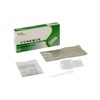Pregnancy Tests
“The signs of pregnancy can be so ambiguous or difficult to interpret that women are often thought to be pregnant when they’re not – and yet in other cases, a pregnancy isn’t recognised until very late. Midwives and women themselves are not the only ones who can get it wrong – until the 18th century doctors had very little clue about the physical signs either.”
Based on Jacques Gélis: Birth – Folklore, rituals and practices from 1500 to 1900
Pregnant or not pregnant – that all-important question. Nowadays we can find out the answer in no time: a urine test from the chemist’s can tell you in just a few minutes, even shortly before your period is due. It is chemistry that makes this possible.
Until the 1970s, the gold standard was the frog test. The accuracy of frogs as biological indicators was comparable with that of the tests used today, but it took considerably longer and was more labour-intensive. The basis for the biological test was the similarity between the pregnancy hormone hcG and luteinizing hormone (LH), which is used by the brain to regulate ovulation or sperm production. In pregnant women, high levels of hCG are present in the urine. In animals, this has the same effect as over-stimulation with the sex hormone LH, and produces the same (described) reactions.
The first immunological tests for the pregnancy hormone hCG using biochemical methods were introduced in 1960; however, they were still not very accurate. Women had to wait until two weeks after a missed period before hCG levels would be high enough for the test result to be reliable.
It wasn’t until 1975 that there was a decisive breakthrough for quick and reliable early confirmation of pregnancy, in the form of monoclonal antibodies. Only then did it become possible to tell the difference reliably between the pregnancy hormone hcG and luteinizing hormone (LH), and only then was it finally possible to have early confirmation of pregnancy without using live animals.

 Baby plus
Instant Pregnancy Test. Easy, reliable, on the spot. Within three …
Baby plus
Instant Pregnancy Test. Easy, reliable, on the spot. Within three …
 BB news plus
Contraceptive case. Urine test pen in an outer box. Plus …
BB news plus
Contraceptive case. Urine test pen in an outer box. Plus …
 BTest Compact
Pregnancy test. Early detection testing stick. Easy to use, quick, …
BTest Compact
Pregnancy test. Early detection testing stick. Easy to use, quick, …
 Clearblue
Pregnancy Test. Early detection Digital
Clearblue
Pregnancy Test. Early detection Digital
 Clearblue
Pregnancy test. In the ÖGF (Austrian Society for Family Planning) …
Clearblue
Pregnancy test. In the ÖGF (Austrian Society for Family Planning) …
 Duogynon
In the 1960s and early 1970s, women who suspected they …
Duogynon
In the 1960s and early 1970s, women who suspected they …
 Egens
The Chinese pregnancy test ‘Egens’ is packaged in a white-green …
Egens
The Chinese pregnancy test ‘Egens’ is packaged in a white-green …
 Femtest
The white and pink cardboard box contains a pregnancy test …
Femtest
The white and pink cardboard box contains a pregnancy test …
 GraviQUICK by Biomar
Mauve box with white overprint. Instructions for use can be …
GraviQUICK by Biomar
Mauve box with white overprint. Instructions for use can be …
 HCG pregnancy test
One Step HCG Urine Test
HCG pregnancy test
One Step HCG Urine Test
 Instant Answer
'Instant Answer' is a pregnancy test from China. In addition …
Instant Answer
'Instant Answer' is a pregnancy test from China. In addition …
 Merckotest® UCG (Urine chorionic gonadotropin)
Ready-to-use reagent kit for determining pregnancy immunologically
Merckotest® UCG (Urine chorionic gonadotropin)
Ready-to-use reagent kit for determining pregnancy immunologically
 Nurse
'Nurse' is the brand of a Chinese pregnancy test. The …
Nurse
'Nurse' is the brand of a Chinese pregnancy test. The …
 Pregnancy Early Test
The tip of the test stick is held in the …
Pregnancy Early Test
The tip of the test stick is held in the …
 Pregnancy Early Test
for self-application
Pregnancy Early Test
for self-application
 Pregnancy in the very early phase
Chinese pregnancy test in a white cardboard box with black …
Pregnancy in the very early phase
Chinese pregnancy test in a white cardboard box with black …
 Pregnancy quick test
The tip of the test stick is held in the …
Pregnancy quick test
The tip of the test stick is held in the …
 Pregnancy strip test
The tip of the test strip is held in the …
Pregnancy strip test
The tip of the test strip is held in the …
 Pregnancy test digital
The tip of the test stick is held in the …
Pregnancy test digital
The tip of the test stick is held in the …
 Pregnancy Tests
Pregnafix. Strips for self-application
Pregnancy Tests
Pregnafix. Strips for self-application
 Pregnancy Tests
The tip of the test stick is held in the …
Pregnancy Tests
The tip of the test stick is held in the …
 Pregnancy test strips
The tip of the test strip is held in the …
Pregnancy test strips
The tip of the test strip is held in the …
 Pré-Test
A single-step, rapid pregnancy test. Highly sensitive: already up to …
Pré-Test
A single-step, rapid pregnancy test. Highly sensitive: already up to …
 Safe'n Easy
Home pregnancy test. Maximum assurance, control function, unambiguous display, easily …
Safe'n Easy
Home pregnancy test. Maximum assurance, control function, unambiguous display, easily …
 Slide Pregnancy Test (Roche)
The box contains a small green bottle with anti-HCG serum …
Slide Pregnancy Test (Roche)
The box contains a small green bottle with anti-HCG serum …